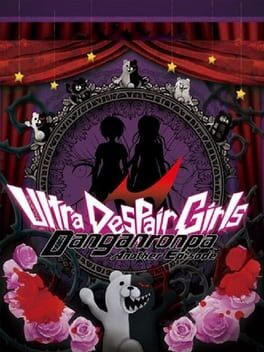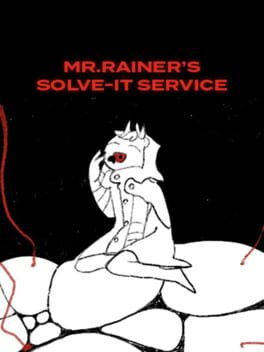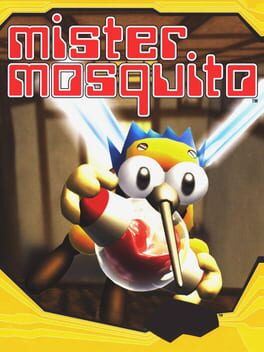FMTownsParty
687 Reviews liked by FMTownsParty
PaRappa the Rapper
1996
the establishment fears when a normie instagram explore tab girl and a mentally ill fujo become stalwart allies. let's go ladies!
alright, time for an actual review, albeit low effort. you can't convince me this isn't actually a grasshopper manufacture title in disguise. its lurid and gaudy spin-off premise replete with masafumi takadas acidic electronica, occasionally psychedelic environments, and frequent parodic overtones share much in common with GHM's scuzzier, more mercenary body of work. these segments are incredibly unpolished, but not unenjoyable.
similarly, the half of the narrative that's komaru and the best character from the first game interacting with each other lands well-enough that i consider it better than anything in the first two games! though it's true i don't have any particular love or reverence for either of those, for reasons sharply articulated by my respected peer BlueTigerSide's work. your mileage in this regard is likely to vary.
unfortunately this half of the narrative intersects with the separate half that attempts to be an examination of child abuse, depictions of which range from 'aggressively mediocre and one-dimensional but bearable through gritted teeth' to 'abhorrent and irresponsible with not even a semblance of anchoring in a story as unserious and fickle as this'. this half is markedly worse than anything in the first two games. the sudden explication of abuse in kotokos chapter particularly is like having an anvil fall on you. not attempting to be reductive here with regards to menial discussions of responsible depiction but this is a case where the story actively cannot handle the sheer weight of its inclusion, and doesn't even try to (instead opting to continue undeterred with the usual generalized insincerity), which to me at least scans as repugnant and honestly vile. nothing more to say about this one really, i mean what they're posturing at here is more or less in-line with what the rest of the series is about but it just comes across as tasteless and i think the narrative spending the first two chapters being mostly breezy is the primary facilitator of this extreme whiplash. would have been fairly manageable to just change some things around and have something a bit more solid.
alright, time for an actual review, albeit low effort. you can't convince me this isn't actually a grasshopper manufacture title in disguise. its lurid and gaudy spin-off premise replete with masafumi takadas acidic electronica, occasionally psychedelic environments, and frequent parodic overtones share much in common with GHM's scuzzier, more mercenary body of work. these segments are incredibly unpolished, but not unenjoyable.
similarly, the half of the narrative that's komaru and the best character from the first game interacting with each other lands well-enough that i consider it better than anything in the first two games! though it's true i don't have any particular love or reverence for either of those, for reasons sharply articulated by my respected peer BlueTigerSide's work. your mileage in this regard is likely to vary.
unfortunately this half of the narrative intersects with the separate half that attempts to be an examination of child abuse, depictions of which range from 'aggressively mediocre and one-dimensional but bearable through gritted teeth' to 'abhorrent and irresponsible with not even a semblance of anchoring in a story as unserious and fickle as this'. this half is markedly worse than anything in the first two games. the sudden explication of abuse in kotokos chapter particularly is like having an anvil fall on you. not attempting to be reductive here with regards to menial discussions of responsible depiction but this is a case where the story actively cannot handle the sheer weight of its inclusion, and doesn't even try to (instead opting to continue undeterred with the usual generalized insincerity), which to me at least scans as repugnant and honestly vile. nothing more to say about this one really, i mean what they're posturing at here is more or less in-line with what the rest of the series is about but it just comes across as tasteless and i think the narrative spending the first two chapters being mostly breezy is the primary facilitator of this extreme whiplash. would have been fairly manageable to just change some things around and have something a bit more solid.
Mister Mosquito
2001
there's often too much emphasis placed on the value of narrative that is intrinsically gamey - stories that 'can only be told within the parameters and constructs of a game'. the idea here is simple: one wants to demonstrate the value their medium can bring to the table, so naturally any stories that can 'only' exist as a game and would face extreme adaptational hurdles presents the most appealing case for games as art.
i think this line of thought is suffocating, though. leaving aside the fact that this thwarts and diminishes the potential and creativity of other mediums in adaptation, the kinds of narratives that are lauded for best-in-class video game storytelling are often entirely subservient to structure or gimmick, or engage in reflexive and banal meta exercises. what's more, i'd posit that most (maybe even all) video game narratives are only feasible within the context of video games. taking play seriously means looking for the syntax linking the abstraction of mechanics to traditional forms of storytelling and presentation and the bearing that the coalescence of the two has on emotion and thought.
all this is to say that 13 sentinels represents another homecoming for the 'stories that are beholden to complex ADV structure' genre, and that it distinguishes itself from the usual suspects with nothing but endearing and unrelenting passion for its subject matter while considering some surprisingly insightful meditations on japans relationship to the media environment its fostered since the post-war era. character interactions are really fun and they're easy to get attached to, its breezy and freeform format makes for some incredibly comfortable gaming, and yes - it takes a lot of skill to hold a narrative this ridiculously convoluted together. 13 sentinels is practically bursting at the seams, but it's pretty sharp in how it chooses to disseminate its key narrative points. i also found it refreshing in that its far more shoujo than it is shonen.
this is really more of a pulpy 3.5 than a 4 - it's pretty scuffed mechanically and even structurally. it loses a significant amount of steam in the last quarter of the game (having exhausted a lot of its appeal and doing itself no favours when the emotional resonance the final battle should have fails to land), its RTS component can be exhilirating but fails to integrate itself as essential within the ADV structure and is often unbalanced to its own detriment, and certain characters get relegated to expository mouthpieces with only the occasional bursts of charm buoying their place within the game (gouto being the primary offender here).
still, how can i argue with a game in which ultimately, the brash and youthful human spirit triumphs over the petty squabbles and needlessly labyrinthine overcomplications of adults?
i think this line of thought is suffocating, though. leaving aside the fact that this thwarts and diminishes the potential and creativity of other mediums in adaptation, the kinds of narratives that are lauded for best-in-class video game storytelling are often entirely subservient to structure or gimmick, or engage in reflexive and banal meta exercises. what's more, i'd posit that most (maybe even all) video game narratives are only feasible within the context of video games. taking play seriously means looking for the syntax linking the abstraction of mechanics to traditional forms of storytelling and presentation and the bearing that the coalescence of the two has on emotion and thought.
all this is to say that 13 sentinels represents another homecoming for the 'stories that are beholden to complex ADV structure' genre, and that it distinguishes itself from the usual suspects with nothing but endearing and unrelenting passion for its subject matter while considering some surprisingly insightful meditations on japans relationship to the media environment its fostered since the post-war era. character interactions are really fun and they're easy to get attached to, its breezy and freeform format makes for some incredibly comfortable gaming, and yes - it takes a lot of skill to hold a narrative this ridiculously convoluted together. 13 sentinels is practically bursting at the seams, but it's pretty sharp in how it chooses to disseminate its key narrative points. i also found it refreshing in that its far more shoujo than it is shonen.
this is really more of a pulpy 3.5 than a 4 - it's pretty scuffed mechanically and even structurally. it loses a significant amount of steam in the last quarter of the game (having exhausted a lot of its appeal and doing itself no favours when the emotional resonance the final battle should have fails to land), its RTS component can be exhilirating but fails to integrate itself as essential within the ADV structure and is often unbalanced to its own detriment, and certain characters get relegated to expository mouthpieces with only the occasional bursts of charm buoying their place within the game (gouto being the primary offender here).
still, how can i argue with a game in which ultimately, the brash and youthful human spirit triumphs over the petty squabbles and needlessly labyrinthine overcomplications of adults?
Neo Turf Masters
1996
Vampire Survivors
2021
Surprised by how little I hate this. On paper, it's pure gunk of a game, all about being a little seratonin plant that stimulates the brain with the fun chemicals by employing the most base level of visual power escalation. It's not just number go up, it's projectile go so Up you can barely see the field anymore. It's all pretty basic stuff, but that's the appeal - a game stripped down to bare essentials, the character arc of a fully-fledged Metroidvania condensed to maybe 30-minute intervals. A thin Roguelite affair with all the trappings that smacks of a Flash golden-era desktop toy. I'm happy to call this game shite, but it's like yelling at a cheap stress ball and I am well aware of the desperate things we do when we have to listen to a podcast. The veneer of Vampire Survivors is pretty hilarious, uses Castlevania's aesthetic right down to stealing monster designs and items and stuff, alongside this unashamed casino spin where you're pulling gatchas from chests and rolling for good pickups. The music and sound effects sound like a pub fruit machine constantly screaming for attention all the while I'm mowing down the devil's legions in gothic castles.
I see the appeal, I really do, but I'm one of those freaks that watches a movie without tearing my eyes off the screen to blink. Stripping down a game to the point where it is nothing but mechanical gratification isn't my thing, I just need the narrative thrust or linear hand-crafted oven-cooked pomp and care or else a game just loses me and I forget it the moment it exits my peripheral. If I was a kid that had to pretend to do work in IT class in the year of our lord 2022 this would probably be my go-to, but I was definitely better off doing the same with Warning Forever.
I see the appeal, I really do, but I'm one of those freaks that watches a movie without tearing my eyes off the screen to blink. Stripping down a game to the point where it is nothing but mechanical gratification isn't my thing, I just need the narrative thrust or linear hand-crafted oven-cooked pomp and care or else a game just loses me and I forget it the moment it exits my peripheral. If I was a kid that had to pretend to do work in IT class in the year of our lord 2022 this would probably be my go-to, but I was definitely better off doing the same with Warning Forever.
Inside
2016
I'm glad to inform that Inside's dystopic orwellian nightmare is still an effective demonstration of what strong compelling imagery and setting can do for storytelling, acting as spiritual sequel to what was an otherwise meandering experience that indulged on the worst tendencies and trends of the indie "games are art" landscape, trimming out most of the unnecessary fat that would get in the way of the actual meat of the "fragile boy going through a hostile environment" concept.
Beyond the immediately noticeable vast improvement in texture, color, sound design and animation work Inside has over Limbo's amateurish monochrome and blurred style, the addition of depth to its massive and imposing backgrounds that juxtapose with the main protag's railroaded 2D axis manages to instill a sense of bleakness and insignificance unmatched in videogame settings, and utilizing its industrial and desolate landscapes as the core instrument to tell its story, the limited dimension allowed to the player is enough to raise intrigue and curiosity as Inside deliberately ofuscates and limits what you glimpse off its distant and alluring backgrounds.
Tying it all up, you have a seamless and intuitive gameplay experience that manages to rectify the lanky and awkward controls that bogged down Limbo and that instead focuses more on the strengths of the cinematic platformer genre, conveying narrative through the pure act of constant movement. Replaying it again, Inside proves to be a much more exasperating endeavour, as you are stopped dead on your tracks to solve puzzles more often than you would like. Fortunately, the fluid animations and perceptible interactivity keep a brisk pace going and utilize said puzzles to reinforce the themes and narrative of the game with a level of craftmanship that Limbo rarely ever managed to pull off.
These aspects alone put Inside on a pedestal far and above Limbo's artistic aspirations, but it's the finale that elevates it beyond what people ever expected it to achieve all the way back in 2016. The centerpiece of Inside and what the whole game builds towards to, the abrupt shift it takes in its last act is still one of the most incredible and well crafted turns I have ever seen a videogame pull off, feeling simultaneously alien and second nature to control and barrelling its way into a catharsis that recontextualizes what came before it and fills its final note with poignancy by the mere act of taking control away from you for a few secs, as you flick the analog sticks one last desperate time.
Much has already been said about Inside's meta commentary on the nature of player agency and the illusion of control, interpretations that are made evident with the unlocking of the secret ending and the decoding of the game's plot, and while I understand that could lead to some people eye rolling as we get yet another postmodern game using the nature of the medium to exploit these concepts, I think Inside manages to pull it off solely based on the strength of its thematic cohesiveness that brings it all together at the end. And its impressive how Inside is able to balance its prevasive and easily understood authoritarian imagery with more subtle and easy to miss nuances that turn a motionless chick in the background into a masterclass of foreshadowing and establish a simple hidden in plain sight diorama as the game's version of 1984's "boot on a human face".
Regardless, Inside's ability to keep its subtext hidden in its scenery is its biggest strength, running instead on tone and atmosphere alone, telling all you need to know from the first moment you take control of the boy in red, and allowing the player the decision to be invested or not in its world, one you will desperately want to get inside of.
Beyond the immediately noticeable vast improvement in texture, color, sound design and animation work Inside has over Limbo's amateurish monochrome and blurred style, the addition of depth to its massive and imposing backgrounds that juxtapose with the main protag's railroaded 2D axis manages to instill a sense of bleakness and insignificance unmatched in videogame settings, and utilizing its industrial and desolate landscapes as the core instrument to tell its story, the limited dimension allowed to the player is enough to raise intrigue and curiosity as Inside deliberately ofuscates and limits what you glimpse off its distant and alluring backgrounds.
Tying it all up, you have a seamless and intuitive gameplay experience that manages to rectify the lanky and awkward controls that bogged down Limbo and that instead focuses more on the strengths of the cinematic platformer genre, conveying narrative through the pure act of constant movement. Replaying it again, Inside proves to be a much more exasperating endeavour, as you are stopped dead on your tracks to solve puzzles more often than you would like. Fortunately, the fluid animations and perceptible interactivity keep a brisk pace going and utilize said puzzles to reinforce the themes and narrative of the game with a level of craftmanship that Limbo rarely ever managed to pull off.
These aspects alone put Inside on a pedestal far and above Limbo's artistic aspirations, but it's the finale that elevates it beyond what people ever expected it to achieve all the way back in 2016. The centerpiece of Inside and what the whole game builds towards to, the abrupt shift it takes in its last act is still one of the most incredible and well crafted turns I have ever seen a videogame pull off, feeling simultaneously alien and second nature to control and barrelling its way into a catharsis that recontextualizes what came before it and fills its final note with poignancy by the mere act of taking control away from you for a few secs, as you flick the analog sticks one last desperate time.
Much has already been said about Inside's meta commentary on the nature of player agency and the illusion of control, interpretations that are made evident with the unlocking of the secret ending and the decoding of the game's plot, and while I understand that could lead to some people eye rolling as we get yet another postmodern game using the nature of the medium to exploit these concepts, I think Inside manages to pull it off solely based on the strength of its thematic cohesiveness that brings it all together at the end. And its impressive how Inside is able to balance its prevasive and easily understood authoritarian imagery with more subtle and easy to miss nuances that turn a motionless chick in the background into a masterclass of foreshadowing and establish a simple hidden in plain sight diorama as the game's version of 1984's "boot on a human face".
Regardless, Inside's ability to keep its subtext hidden in its scenery is its biggest strength, running instead on tone and atmosphere alone, telling all you need to know from the first moment you take control of the boy in red, and allowing the player the decision to be invested or not in its world, one you will desperately want to get inside of.
The Surge
2017
My first Civ, be nice to me.
The game feels little lost and suffocated by its own tangled web of subsystems that don't feel naturalistically enveloped by what is almost fundamentally brilliant. It doesn't bear much surprise to learn that most of these rather clumsy or extraneous mechanics were added in post-release updates and expansions, but can mercifully be disabled. I'm particularly un-fond of world hazards, congress, loyalty, and governers to name a few. There is every possibility I'll see the light and turn these on when my aptitude for this game builds up though honestly.
As the ball gets rolling it really is shockingly fun, I'm a fan of the inclusion of different methods to win games beyond just pure warlord domination. Culture and diplomacy make me feel like a devious little worm shmoozing my way under people's noses, it's great, and I'm excited to figure out whatever the deal is with faith. Science was apparently hit by the ugly stick in VI specifically - its victory requirements are kind of insane, require a lot of planning from turn one, and seem like a dull grind as you hope your opponents are just doing nothing.
A personal standout surprise here is the character animation for all of the leaders. This shit's better than Pixar I swear to god, excellent attention to detail in the subtle face and finger movements. Nobody in a videogame more expressive than Kupe.
The game feels little lost and suffocated by its own tangled web of subsystems that don't feel naturalistically enveloped by what is almost fundamentally brilliant. It doesn't bear much surprise to learn that most of these rather clumsy or extraneous mechanics were added in post-release updates and expansions, but can mercifully be disabled. I'm particularly un-fond of world hazards, congress, loyalty, and governers to name a few. There is every possibility I'll see the light and turn these on when my aptitude for this game builds up though honestly.
As the ball gets rolling it really is shockingly fun, I'm a fan of the inclusion of different methods to win games beyond just pure warlord domination. Culture and diplomacy make me feel like a devious little worm shmoozing my way under people's noses, it's great, and I'm excited to figure out whatever the deal is with faith. Science was apparently hit by the ugly stick in VI specifically - its victory requirements are kind of insane, require a lot of planning from turn one, and seem like a dull grind as you hope your opponents are just doing nothing.
A personal standout surprise here is the character animation for all of the leaders. This shit's better than Pixar I swear to god, excellent attention to detail in the subtle face and finger movements. Nobody in a videogame more expressive than Kupe.
Silent Hill 3
2003
The most terrifying, oppressive, claustrophobic experience I've had in the medium is no surprise a stalking disturbing message of an encroaching patriarchal faith. Heather wants nothing to do with it, and neither will I. Monsters of repressed memories and physical/sexual trauma stalk the corridors, but catharsis is found in making them all Burn. Aborting god is probably the rawest turn on killing god tbh. I personally got lost in the woods of the threads near the end but I think on just initial reflection that there's a large point in there about an incomprehensibly massive societal issue that makes it difficult to form into something tangible (e.g. male gaze and abuse). It's also like a crystalized end to everything the series culminated in before, tying everything back together. Genuinely super well crafted, and a crazy good final message. That cycle of disparaging hatred is still overturned by the real spark of sympathy, we just want love.
Nekopara Vol. 1
2014
Nekopara Vol. 1
2014
Nekopara is a series of adult visual novels you've most likely heard of in passing from post-post-post-ironic weeaboos online who wear Ahegao hoodies in public and think being horny is a personality trait. It's the funny anime game about the catgirl cafe that's garnered a status comparable to something like Bad Rats: a gag gift best sent to your friends during a Steam sale for a quick laugh (which is how I obtained my copy back in high school), or something you play so your "hilarious" Steam status pops up on your friend's screens during their CS: GO matches. In honor of the holiday, I thought "Hey, wouldn't it be funny if I played the porn game about cat girls and published a review on it online?", but while I slogged through one of the most joyless visual novels I've ever read, I came away with a lot to ruminate on betwixt the standard anime hijinks and incestuous little sister jokes.
Now obviously, Nekopara is porn, and if you came here expecting anything other than the world's most boring set-up to catgirl hentai, you were barking up the wrong tree. But as I was reading through lines and lines of filler text and moeblob cuteness, I found myself thinking about the common archetypes you find in the female characters written for this sort of media: the incestuous little sister romance, the (worryingly) child-like girl, or in Nekopara's case, pets. These all have a connective through-line, which is a lack of independent agency and an innate dependency on a superior of some kind (usually the self-insert main character of the story.) This throughline isn't something specific to Japanese media by any means, but these are just some of the few I noticed while reading Vol. 1.
The very concept of catgirls as they are written in Nekopara are a bastard child of the aforementioned archetypes mentioned previously: They're pretty explicitly stated in the text to be analogous to cats, displaying numerous cat-like mannerisms. They have a limited understanding of human society and abstract concepts (money, emotional awareness, etc.) and are even required to be "chipped" in a sense via the possession of an "Independent Action Permit", a mix between an ID and a Driver's License, in order to be allowed in polite society without being detained by Animal Control. They mature at roughly the same rate as a regular cat (it's stated offhandedly that a 6 month old catgirl is roughly equivalent to a 12 year old girl), but retain roughly the same intellect and mannerisms of a child. But most importantly for Nekopara's main intent, they can't bear human children, the existence of catgirl-human sexual relations is both normal and widely accepted alongside those who keep them as regular pets or family members in this society, and they are "excessively honest and uncomplicated", which means that emotional miscommunication and conflict basically never happens (unless its in service of anime tropes, like "jealous clingy tsundere").
What this means is that Nekopara's catgirls are the "idealized woman" for the target audience: a walking fleshlight in the shape of an girl, who has an innate attraction to the self-insert main character and will basically never reject them. A mirage of a character who only exists for pleasure. This is taken to the extreme in the context of Nekopara, in which the main character (who has helped raise the two leading catgirls ever since they were kittens and explicitly views them as daughters and family) enters a sexual relationship with what is essentially his pet cats/younger twin sisters, the ultimate fetishistic culmination of tropes to create the most dependent females possible for the express purpose of sexual pleasure. Incestuous threesomes and shower sex are sandwiched in-between the most trite rom-com anime scenarios and paragraphs of pure filler text to create the perfect visual novel for the modern-day weeb, the equivalent of a corporate blockbuster designed to appeal to the otaku equivalent of John Q. Public. This isn't an original conclusion by any means, and it's one that's not even necessarily a negative in terms of Nekopara's main goal (be titillating and provide comfort to its target audience), but it's telling that the series can basically excise the naughty 18+ bits from its story and still achieve success in other medium adaptations with little editing to the main girls' writing.
It's a formula that obviously works: Nekopara has numerous sequels, spinoffs and is one of the biggest rags-to-riches success stories to come from the eroge scene in recent memory. It's the kind of monumental success that makes someone with an ahegao anime girl avatar on Twitter thrust their arms towards the sky in joy to celebrate the "Based" culture of the Land of the Rising Sun, as if the success of an eroge where a guy sticks his dick in his pet cat is some kind of cultural dunk on the puritanical Westerners who would seek to deprive them of their catgirl waifus. Nekopara wasn't the first, nor was it the last time a bog-standard anime-flavored media property with weird sexual content and weirder fans is used as another lamppost for the proverbial moths to flock to. It's just another drop in the bucket as far as weeaboo culture is concerned.
Now obviously, Nekopara is porn, and if you came here expecting anything other than the world's most boring set-up to catgirl hentai, you were barking up the wrong tree. But as I was reading through lines and lines of filler text and moeblob cuteness, I found myself thinking about the common archetypes you find in the female characters written for this sort of media: the incestuous little sister romance, the (worryingly) child-like girl, or in Nekopara's case, pets. These all have a connective through-line, which is a lack of independent agency and an innate dependency on a superior of some kind (usually the self-insert main character of the story.) This throughline isn't something specific to Japanese media by any means, but these are just some of the few I noticed while reading Vol. 1.
The very concept of catgirls as they are written in Nekopara are a bastard child of the aforementioned archetypes mentioned previously: They're pretty explicitly stated in the text to be analogous to cats, displaying numerous cat-like mannerisms. They have a limited understanding of human society and abstract concepts (money, emotional awareness, etc.) and are even required to be "chipped" in a sense via the possession of an "Independent Action Permit", a mix between an ID and a Driver's License, in order to be allowed in polite society without being detained by Animal Control. They mature at roughly the same rate as a regular cat (it's stated offhandedly that a 6 month old catgirl is roughly equivalent to a 12 year old girl), but retain roughly the same intellect and mannerisms of a child. But most importantly for Nekopara's main intent, they can't bear human children, the existence of catgirl-human sexual relations is both normal and widely accepted alongside those who keep them as regular pets or family members in this society, and they are "excessively honest and uncomplicated", which means that emotional miscommunication and conflict basically never happens (unless its in service of anime tropes, like "jealous clingy tsundere").
What this means is that Nekopara's catgirls are the "idealized woman" for the target audience: a walking fleshlight in the shape of an girl, who has an innate attraction to the self-insert main character and will basically never reject them. A mirage of a character who only exists for pleasure. This is taken to the extreme in the context of Nekopara, in which the main character (who has helped raise the two leading catgirls ever since they were kittens and explicitly views them as daughters and family) enters a sexual relationship with what is essentially his pet cats/younger twin sisters, the ultimate fetishistic culmination of tropes to create the most dependent females possible for the express purpose of sexual pleasure. Incestuous threesomes and shower sex are sandwiched in-between the most trite rom-com anime scenarios and paragraphs of pure filler text to create the perfect visual novel for the modern-day weeb, the equivalent of a corporate blockbuster designed to appeal to the otaku equivalent of John Q. Public. This isn't an original conclusion by any means, and it's one that's not even necessarily a negative in terms of Nekopara's main goal (be titillating and provide comfort to its target audience), but it's telling that the series can basically excise the naughty 18+ bits from its story and still achieve success in other medium adaptations with little editing to the main girls' writing.
It's a formula that obviously works: Nekopara has numerous sequels, spinoffs and is one of the biggest rags-to-riches success stories to come from the eroge scene in recent memory. It's the kind of monumental success that makes someone with an ahegao anime girl avatar on Twitter thrust their arms towards the sky in joy to celebrate the "Based" culture of the Land of the Rising Sun, as if the success of an eroge where a guy sticks his dick in his pet cat is some kind of cultural dunk on the puritanical Westerners who would seek to deprive them of their catgirl waifus. Nekopara wasn't the first, nor was it the last time a bog-standard anime-flavored media property with weird sexual content and weirder fans is used as another lamppost for the proverbial moths to flock to. It's just another drop in the bucket as far as weeaboo culture is concerned.













